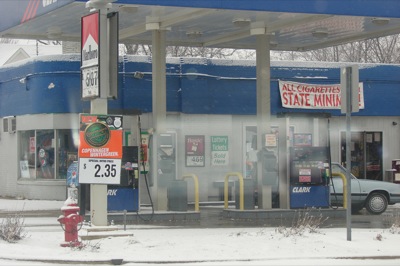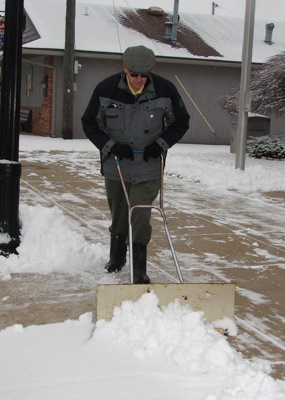Wednesday, February 3rd, 2010
Economical engineering
Mercer County engineers overcome budget deficiencies to keep roadways safe
By Shelley Grieshop
Despite being snubbed by stimulus dollars and hit with revenue shortages and a tight budget, the Mercer County engineering department still managed to complete a hefty workload in 2009.
Engineer Jim Wiechart cited several key reasons his staff was able to complete the ambitious schedule. The first was weather.
"Although it was not entirely beneficial to those among us in agribusiness, the dry year of 2009 greatly aided in road and bridge construction projects," he said.
However, even the best weather conditions won't facilitate roadwork progress if funding isn't available. Wiechart applied for American Recovery and Reinvestment Act (stimulus) funds but received nothing despite having many "shovel ready" projects.
"When I inquired (for the reason why we received no funds) on my own I could not seem to get a meaningful answer," Wiechart said. "My perception is and was that it was a moderately to significant political process."
He would have placed more faith in the distribution process "if licensed engineers had made those decisions," he explained.
Although the federal bucks would have been a bonus, Wiechart said his department had a successful year without it.
"Unlike our federal government, we must balance our budget and live within our means," he said.
Income from gas tax and license fees - which represents about 60 percent of funding for road and bridge projects - dropped $74,000 from 2008 to 2009. Expenses - particularly the cost of asphalt resurfacing - increased.
To combat the shortfall, the department applied for and received nearly $2.3 million in state and federal grants in 2009. The grants increased revenue by $340,000 over 2008. The money flowed straight to contractors for specific projects, Wiechart added.
Since 1999, the engineering department has obtained almost $19 million in state and federal funds.
Projects completed in 2009 included resurfacing and some trench widening on nearly nine miles of roadways; chipping and sealing of more than 26 miles; and pavement and shoulder widening of four roads. The widening projects carried a price tag of $1.6 million.
Wiechart's goal is to have all county roads widened to 24 feet by 2024.
"Studies prove that widening pavements to 24 feet greatly decreases the likelihood of accidents. They make the roadways much safer to drive," he said, adding it is better for the agriculture and commercial vehicles that also use the local roads.
Twenty-two bridge and large culvert replacement projects kept the agency busy in 2009. The biggest endeavor was a bridge replacement on Frysinger Road over the St. Marys River in Dublin Township, which cost $625,000 and took four months to complete.
One of Wiechart's long-term goals is to replace all bridges in the county that require load restrictions. There are two remaining: the Township Line Road Bridge and the Tomlinson Road Bridge.
Wiechart's crews also applied pavement markings and performed general maintenance such as sign replacement, mowing and snow and ice removal. The engineer's office also partners each year with the county's solid waste office and various board of township trustees in sponsoring litter pick-up programs along county ditches. The county furnishes litterbags, safety vests and signs, and pays the tipping fees to dispose of the trash.
Wiechart's staff of 25 full-time employees - down from 39 in 1984 - did not receive raises in 2009 due to the reduced budget. Salaries and fringe benefits decreased by 1.02 percent from 2006-2009, he said.
While maintaining 410 bridges and 835 miles of township and county roads, Wiechart said his agency hopes to continue its aggressive pace.
"Improving the safety of our local roadways is a primary mission of our office," he said. "We continue to improve our efficiency in engineering operations and management to provide the best value that we possibly can for every tax dollar spent."



